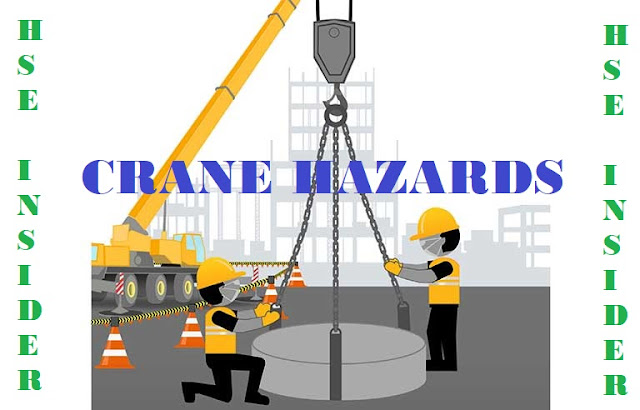Crane Hazards & Major Causes of
Crane Accident
EXCAVATION SAFETY HAZARDS & CONTROL
Compressed gas cylinder safety
Hazards can be classified as:
Physical Hazards:
Temperature, ionizing or non-ionizing
radiation, excessive noise, electrical exposure,
working from heights, and unguarded
machinery.
Mechanical Hazards: Protruding and
moving parts.
Chemical Hazards: These appear when
a worker is exposed to chemicals in the workplace..
Biological Hazards: viruses,
bacteria, fungus, parasites, and any living organism that can infect or
transmit diseases to human beings.
Ergonomic Hazards: Total physiological
demands of the job upon the worker, even beyond productivity, health, and
safety.
Psychosocial Hazards: variety of psychosocial
factors that workers may find to be unsatisfactory, frustrating, or
demoralizing.
Crane Hazards
Improper load rating, Excessive
speeds, Inadequate communication or hand signals, Inadequate inspection and
Maintenance, Unguarded parts,
Unguarded swing radius, Working too close to power lines, Improper exhaust
system, Shattered windows, No steps/guardrails walkways, No boom angle
indicator, Not using outriggers, Inactive Limit Switch/ Asli/boom, Over Hoist
switch, Inexperienced and over experienced operator, rigger.
Major Causes of Crane Accident
Crane rigging failures.(Rope
,Chains,wires, support etc)
Crane mechanic failures
Cranes colliding with other
buildings
Cranes colliding with energized
power lines.
Cranes hitting people with heavy
materials and objects
Cranes dropping heavy materials and
objects
Fall Protection in Construction – OSHA
Cranes overturning
Boom collapse
Crane hook-lifting device failure
Improper crane selection
Instability – unsecured load, load
capacity exceeded, or ground not level or too soft beyond the radius and boom
angle.
Stormy, rainy, windy, rough ,etc
weather
Improper crane set up(out of reach,
Drag loads, Side-load a boom.)
Failing to comply with manufacturer
specifications for crane use.
Lack of communication - the point
of operation is a distance from the crane operator or not in full view of the
operator
Lack of training
Inadequate maintenance or
inspection
By pass the functioning Systems.
Modify or ignore safety devices.
Many more not included here.
All these informations may be
considered for all type of cranes including EOT.
HAZARDOUS AREA CLASSIFICATION PART 4





No comments:
Post a Comment